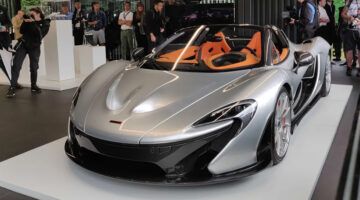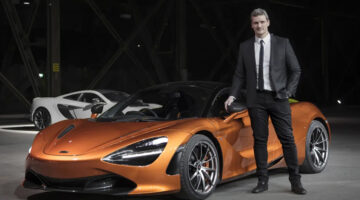crankandpiston.com has a natter with McLaren chief test driver Chris Goodwin to discuss the brand new P1, its performance potential, why its design is so innovative, and how the drive betters even some Formula 1 cars.
[Not a valid template]“The McLaren P1 is definitely the closest thing you’ll find to a Formula 1 racing car as a driving experience. The performance is just mind-blowing.”
When you consider some of the machines McLaren chief test driver Chris Goodwin has driven during his near 17-year stint with the Woking-based company, it’s an impressive claim: the Porsche Carrera GT-baiting McLaren-Mercedes SLR; the MP4-12C, the company’s first stand alone sports car; its GT-dominating GT3 variant; world championship-winning F1 cars, both past – like Lewis Hamilton’s 2008-winning MP4-23 – and legendary, including Ayrton Senna’s 1988 MP4/4. And of course, the McLaren F1. It may well be 20 years old now but the F1’s legacy is as strong as ever.
Which brings us to the predecessor, the all-new all-powerful McLaren P1. It’s the first hypercar since production of just over 100 F1s stopped in 1998, which means it has to be fast. It has to handle superbly. It has to be brilliant. Nothing less will do, a fact Chris is all too well aware of.
“The F1 has for years been the iconic supercar,” Chris explains. “In the day, it was light years ahead of everybody else, and it’s taken quite a few years for everybody else to even catch up. That car is now 20 years old, and that technology is now 20 years old. In the gestation period of the F1 supercar, McLaren was winning 15 out of 16 races in 1988, so it was the benchmark. If you then compare that F1 car with one twenty years later there’s a huge amount more complexity and technology. That’s what the P1 is compared with the F1.”
Those who quickly slammed down their deposit cheques for the P1 will be receiving their new hypertoys within the next few months, and will be keen to see what four years-worth of McLaren development feels like. And this being McLaren – which brings new meaning to the phrase ‘attention to detail’ – said customers are unlikely to be disappointed. Chris is certainly calm, sitting as he is inside the P1 on McLaren’s stand at the Dubai Motor Show, crankandpiston voice recorder stage left.
“My first job for McLaren was to race the F1 GTR in the 1990s,” Chris continues. “It was something that was really cool to be a part of, a really standout product. And I think the P1 one is too. Of course in the 1990s McLaren had fewer rivals. But I think this car will stand the test of time, so ask me in ten or twenty years time whether the P1 is a legendary car. I think it probably will be.
We’re soon taking a walk around the P1, and it’s a mightily impressive piece of kit. McLaren’s established 3799cc twin-turbo V8 pumps out 717bhp and 531lb ft of torque in this model, and that’s not even including the extra 175bhp and 192lb ft available from an IPAs petrol-electric motor (codename M838TQ). At full chat, the P1 will hit 0-100kph in 2.8 seconds, 0-200kph in 6.8 seconds, a barely comprehensible 0-300kph in 16.5 seconds (five seconds quicker than the F1), and an electronically limited top speed of 350kph. And these are performance figures not just derived from the engine. There’s the F1-inspired Drag Reduction System (DRS) to make the car more aerodynamic; a lightweight carbon fibre MonoCage chassis offering unparalleled structural rigidity; a Kinetic Energy Recovery System (KERS) developed to optimise the vehicle’s forward momentum under braking and reserve for future use; RaceActive Chassis Control that lowers the car by 50mm to increase speed in Race mode; and various other electronic gubbins that have been tested, tweaked and then tested and tweaked once again to perfection. Everything on this model is as good as it could possibly be: everything for a reason, remember?
“We set out to produce a car that would represent what McLaren could do with a street legal car, and we’ve thrown all the experience that we’ve derived from our 12C project on it,” Chris explains. “We’ve also been able to utilise a lot of our in-house derived F1 technology. So from the concept we wanted a car that had certain performance figures in a way that was modern and relevant.
“We have a 3.8-litre twin-turbocharged V8 engine mated with a hybrid that’s allowed us to get amazing performance, acceleration and top speed. The carbon fibre chassis is an evolution of the 12C monocoque but is actually a MonoCell, so it incorporates structurally the roof unlike the 12C. Unique hydraulics in the suspension control roll, and there’s an adaptive damping system that has massive range. At the same time the rear wing extends and the whole car really transforms massively itself: there’s 600kg of downforce. It’s absolutely a rocket ship, with more performance than any current regulation driven GT race car.”
Story continues on page 2



